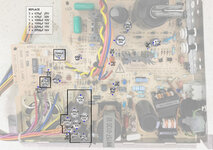falen6
Well-known member
Just to chime in ......... I have exact same problem ........same low 5 volt at power up , slowly climbing to 5 volt then booting
I recapped the board ( well , the caps recommended to replace anyway )
I have the same ( but not as bad) area of protective layer been eaten by leaking electrolite . Looking at xeiters photos above , i thought i was looking at my own a/b board !!
will start changing the chips and diodes mentioned in this thread
Im fiddeling with macs for about 8 years or so now , and I have never seen this before on a classic ....... and after reading this thread it seems this might be an age thing , as in , these classic a/b's have reached the age where they start to spill their insides ....... this problem might become more and more evident with time
great work people ...... I have many things to change thanks to all your work.
I recapped the board ( well , the caps recommended to replace anyway )
I have the same ( but not as bad) area of protective layer been eaten by leaking electrolite . Looking at xeiters photos above , i thought i was looking at my own a/b board !!
will start changing the chips and diodes mentioned in this thread
Im fiddeling with macs for about 8 years or so now , and I have never seen this before on a classic ....... and after reading this thread it seems this might be an age thing , as in , these classic a/b's have reached the age where they start to spill their insides ....... this problem might become more and more evident with time
great work people ...... I have many things to change thanks to all your work.

